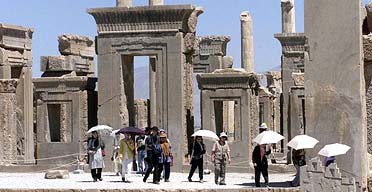Iran's rich architecture and rare treasures threatened by possible US strikesMaev KennedyThe Guardian Mar. 05, 2007 |
Popular 
Trump Nominates Pam Bondi for Attorney General

Netanyahu Cries 'Antisemitism' After International Criminal Court Issues Warrant for His Arrest

FBI Pays Visit to Pro-Palestine Journalist Alison Weir's Home

Matt Gaetz Withdraws from Consideration as Attorney General

As Poll Finds Ukrainians Want to End War, U.S. Pushes Zelensky to Bomb Russia and Expand Conscription
  Tourists visit Persepolis, which lies within 50 miles of the Ardakan and Fasa uranium processing plants. Photograph: Vahid Salemi/AP Tourists visit Persepolis, which lies within 50 miles of the Ardakan and Fasa uranium processing plants. Photograph: Vahid Salemi/APIn his quiet office at the British Museum, among the portraits of long-dead explorers and copies of 3,000-year-old inscriptions, one of the greatest experts on the archaeology of the Middle East has a series of maps of Iranian nuclear installations spread out across his desk. John Curtis's maps fill him with foreboding: because they show how many of Iran's nuclear plants are perilously close to ancient cultural sites. Natanz, home to a uranium enrichment plant, is renowned for its exquisite ceramics; Isfahan, home to a uranium conversion plant, is also a Unesco world heritage site and was regarded in the 16th century as the most beautiful city on earth. Other nuclear installations lie close to Shiraz, dubbed "the city of roses and nightingales", famous for the tombs of medieval poets; Persepolis, the great palace of King Darius, whose ruins are still magnificent; and the 6th century BC tomb of Cyrus the Great, the Persian ruler who was said to have been buried in a coffin of gold. Four years ago Dr Curtis was warning that war in Iraq would be a disaster for some of the oldest and most important sites in the world. He has since seen his worst fears confirmed: the site of ancient Babylon became an American military base; thousands of objects are missing from the national museum at Baghdad; and looted artefacts have been illicitly excavated and smuggled out of the country. Now Dr Curtis dreads seeing history repeated, this time through the escalating threat from the United States against Iran. "Any kind of military activity whatever in Iran, whether aerial bombing or land invasion, would inevitably have the gravest consequences, not only for its people but for its cultural heritage - which should be a matter of concern not just to Iranians but to the whole world," he said. "The main nuclear bases would seem the most likely targets - which would directly threaten two major sites, Isfahan and Natanz." The medieval splendour of those cities, at the height of the power of Islamic Persia from the 13th to the 17th centuries, was built on a cultural history which was already thousands of years old. The history of cities, of writing, of engineering and astronomy began in the ancient centres of Iran and Iraq. "The archaeology is so rich there is almost nowhere that you could say is devoid of interest," Dr Curtis said. "But certainly a list must be compiled of the sites which need the most consideration." Unlike the looted and still shuttered national museum in Baghdad, in Iran the risk is considered less for the national museum in Tehran than for hundreds of major sites with standing buildings and ruins, and thousands of known but unexcavated sites. Some of the structures are in stone, but most are in baked brick with elaborate tile decorations, a building type particularly vulnerable to blast damage. Apart from Isfahan and Natanz, other potentially vulnerable sites cover 3,000 years of the world's history: a stepped stone tomb at Pasargadae, within 50 miles of one of the nuclear sites once held the body of Cyrus the Great, the king who enormously expanded the Persian empire and conquered mighty Babylon in 539 BC. And the ruins of the great city and palace at Persepolis are among the most imposing in the Middle East, despite the fact that it was ransacked by Alexander the Great in 330BC, after the Macedonian defeated the armies of the Persian emperor Darius. The destruction of the palace is still regarded as one of the greatest acts of vandalism in history. Alarm is growing over the potential fate of Iran's treasures. Professor Harriet Crawford, of the Institute of Archaeology in London, one of the archaeologists who sounded the alarm before the Iraq war, said yesterday: "An attack on Iran would not only cause thousands more avoidable deaths, but would also risk inflicting untold damage on its heritage, comparable with that seen in Iraq." Precious stones Persepolis The magnificent palace of Darius, the centrepiece of which is the Hall of 100 Columns, above, was destroyed by Alexander the Great but the ruins, including some standing columns, are still imposing. It lies within 50 miles of the Ardakan and Fasa uranium processing plants Isfahan An ancient site in a fertile river valley, internationally renowned from the 16th century - "Isfahan is half the world" - as the new capital of Shah Abbas I. It is adorned with magnificent mosques, palaces, the second largest square in the world (originally laid out as a polo ground), gardens, fountains and bridges, including a 33-arch bridge dating from 1602. A World Heritage Site, the historic centre is only a few miles from the Isfahan uranium conversion plant Famous for its 13th and 14th century mosques and shrines, now mostly stripped of their spectacular lustre tiles, which are in museums across the world. Fragile baked-brick buildings; very close to the Natanz uranium enrichment plant Tomb of Cyrus the Great A well-preserved stone tomb on a stepped platform. According to the Greek historian Arrian, the king's body lay in a golden coffin under an inscription reading "Mortal! I am Cyrus, son of Cambyses, who founded the Persian empire, and was King of Asia. Grudge me not then my monument." It is situated at Pasargadae, close to Persepolis. The bracelet below was found there |



